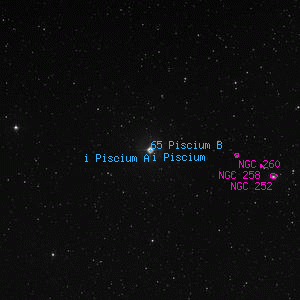i Piscium

Overlaid DSS image of i Piscium, 60' x 60' with north at top and west to the right
Aladin viewer for the region around i Piscium
i Psc, 65 Psc
Σ 61, BD+26 131, WDS J00499+2743AB, HIP 3885
Σ 61, BD+26 131, WDS J00499+2743AB, HIP 3885
| Type | Binary Star |
|---|---|
| Magnitude | 5.57 | Right Ascension | 0h 49' 53.2" (2000) |
| Declination | 27° 42' 37" N |
| Constellation | Pisces |
| Description | Binary 6.3/6.3m @ 4.3" |
Observing Notes
Andrew Cooper
Nov 7, 2020 Waikoloa, HI (map)
20cm f/6 Newtonian, Cave Astrola @ 76x
Seeing: 7 Transparency: 6 Moon: 0%
65 Psc is a splendid binary with a pair of well matched 6th magnitude stars 4.3" apart, 65Psc B is the northwestern member while 65Psc A is the southeastern
Gaia DR2 data shows a good match in parallax and proper motion data indicating a binary system
Captain William Henry Smyth
Mar 4, 1837 No. 6 The Crescent, Bedford, England (map)
150mm f/17.6 refractor by Tully 1827
A close double star, which, though classed in Pisces, is placed by the map artists on the right arm of Andromeda; where it may be struck upon about half-way between π and η. A 6, and B 7. both pale yellow. This fine object was discovered by William Herschel, who registered it thus: Pos. 300°57' Dist. 4".00± Ep. 1783.15
He again measured its position in 1802, when the results seemed to warrant the assumption of a slow retrograde orbital motion; but this is not confirmed by the later observations. Piazzi, who made A the companion, merely records it, " Duplex. Comes sequitur ad Austrum:" but it has been closely examined by H. S. Σ. and D. By assembling the observations in one view, John Herschel arrived at the conclusion that the decrease might be 0°.117 per annum; and supposing the star to revolve uniformly in a circle, its period would be 3077 years. My measures, however, drawn through a similar comparison, yield only -0°.06 per annum, and infer an anmis magnus of a much longer period.
While these sheets are in the press, it is announced that Flamsteed's next star, 66 Piscium, is detected double in the gigantic Poulkova refractor; the components being 6th and 7th magnitudes, and half a second of space asunder.― A Cycle of Celestial Objects Vol II, The Bedford Catalogue, William Henry Smyth, 1844
Other Data Sources for i Piscium
Associated objects for i Piscium
Nearby objects for i Piscium
6 objects found within 60'
| 65 Piscium B | i Piscium A | IC 1584 |
| NGC 252 | NGC 258 | NGC 260 |
Credits...
Drawings, descriptions, and CCD photos are copyright Andrew Cooper unless otherwise noted, no usage without permission.
A complete list of credits and sources can be found on the about page
i Piscium